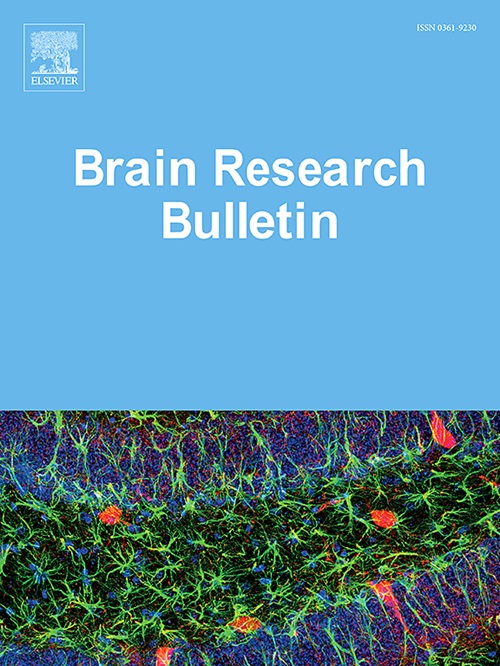Silibinin protects the ischemic brain in mice by exerting anti-apoptotic effects via the EGFR/ERK pathway
IF 3.5
3区 医学
Q2 NEUROSCIENCES
引用次数: 0
Abstract
Apoptosis is a significant occurrence of cell death in the cerebral ischemia process, potentially revealing specific treatment points. Silibinin (SIL) has been proven to regulate a range of biological effects on inflammation, oxidative stress and apoptosis. Meanwhile, the epidermal growth factor receptor (EGFR) has been reported to impact cell apoptosis owing to its proliferative activity, which is in the opposite direction of apoptosis. This brings up the question of whether silibinin modulates apoptosis after cerebral ischemic injury and whether EGFR is involved in mediating this effect. We therefore examined the potential protective role of silibinin in ischemic brain and the underlying mechanisms. We assigned CD1 mice into groups and assessed neurological function via behavioral tests, infarct volume staining, and edema measurement. Neuronal vitality in the infarcted hemisphere was assessed using Nissl staining, while the level of apoptosis was evaluated by detecting cleaved Caspase-3, Bcl-2, and Bax. Penumbra vascular conditions were examined by immunofluorescence and two-photon imaging. Western Blot and immunohistochemistry detected EGFR/ERK level changes. An EGFR inhibitor was used to confirm the involvement of the EGFR/ERK pathway in the disease process. Our findings indicated that silibinin substantially diminished infarct volume and brain edema, reduced neuronal apoptosis following stroke, enhancing neurological function. These effects were accompanied by up-regulation of p-EGFR/EGFR, p-ERK/ERK, and Bcl-2, as well as down-regulation of Bax and cleaved-Caspase3 in ischemic brain tissue post-stroke, while inhibiting EGFR activation attenuated or reversed the anti-apoptotic effects of silibinin. We concluded that silibinin protected the brain after cerebral ischemia by exerting anti-apoptotic effects via the activation of EGFR/ERK signaling pathway.
水飞蓟宾通过EGFR/ERK通路发挥抗凋亡作用,保护小鼠缺血脑
细胞凋亡是脑缺血过程中细胞死亡的重要现象,可能揭示特定的治疗点。水飞蓟宾(SIL)已被证明可调节一系列炎症、氧化应激和细胞凋亡的生物学效应。同时,表皮生长因子受体(epidermal growth factor receptor, EGFR)因其增殖活性而影响细胞凋亡,与细胞凋亡方向相反。这就提出了水飞蓟宾素是否调节脑缺血损伤后的细胞凋亡以及EGFR是否参与介导这一作用的问题。因此,我们研究了水飞蓟宾在缺血性脑中的潜在保护作用及其潜在机制。我们将CD1小鼠分组,并通过行为测试、梗死体积染色和水肿测量来评估神经功能。采用尼氏染色评估梗死半球的神经元活力,通过检测裂解的Caspase-3、Bcl-2和Bax来评估凋亡水平。用免疫荧光和双光子成像检查半影血管状况。Western Blot和免疫组化检测EGFR/ERK水平变化。一种EGFR抑制剂被用来证实EGFR/ERK通路在疾病过程中的参与。我们的研究结果表明水飞蓟宾能显著减少脑梗死体积和脑水肿,减少脑卒中后神经元凋亡,增强神经功能。这些作用伴随着脑卒中后缺血脑组织中p-EGFR/EGFR、p-ERK/ERK和Bcl-2的上调,Bax和cleaved-Caspase3的下调,而抑制EGFR激活会减弱或逆转水飞蓟宾的抗凋亡作用。我们认为水飞蓟宾可能通过激活EGFR/ERK信号通路发挥抗凋亡作用,从而保护脑缺血后的大脑。
本文章由计算机程序翻译,如有差异,请以英文原文为准。
求助全文
约1分钟内获得全文
求助全文
来源期刊

Brain Research Bulletin
医学-神经科学
CiteScore
6.90
自引率
2.60%
发文量
253
审稿时长
67 days
期刊介绍:
The Brain Research Bulletin (BRB) aims to publish novel work that advances our knowledge of molecular and cellular mechanisms that underlie neural network properties associated with behavior, cognition and other brain functions during neurodevelopment and in the adult. Although clinical research is out of the Journal''s scope, the BRB also aims to publish translation research that provides insight into biological mechanisms and processes associated with neurodegeneration mechanisms, neurological diseases and neuropsychiatric disorders. The Journal is especially interested in research using novel methodologies, such as optogenetics, multielectrode array recordings and life imaging in wild-type and genetically-modified animal models, with the goal to advance our understanding of how neurons, glia and networks function in vivo.
 求助内容:
求助内容: 应助结果提醒方式:
应助结果提醒方式:


